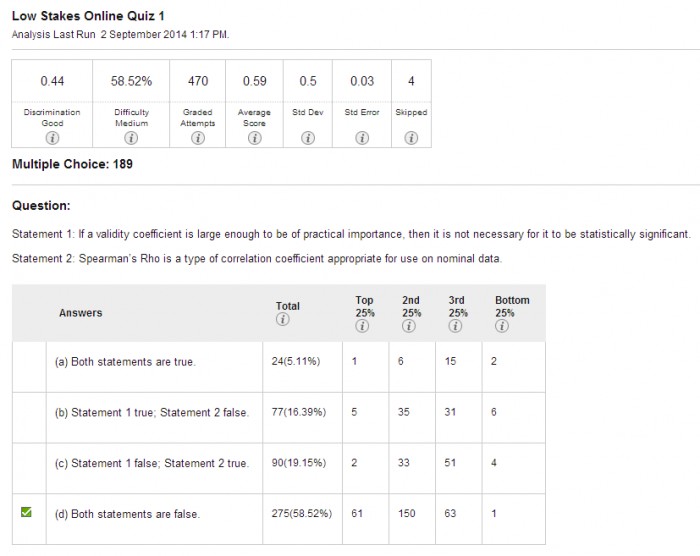Individual Question Analysis (Original)
The results of individual questions can be analysed when you run an Item Analysis (refer Run Item Analysis guide).
Question Statistics Table
- Click on the Show All button to show all the questions.
- Click on the link of the required question.

Individual question
Columns
- Discrimination: Indicates how well a question differentiates between students. A question is considered a good discriminator when students who answer the question correctly also do well on the rest of the test.
- Values can range from -1.0 to +1.0 Questions are flagged for review with a red dot if their discrimination value is less than 0.1. Discrimination values cannot be calculated when the question’ difficulty score is 100% or when all student receive the same score on a question.
Calculation: Discrimination values are calculated with the Pearson correlation coefficient, X represents the scores of each student on a question and Y represents the scores of each student on the test.

- Difficulty: The percentage of students who answered the question correctly. Difficulty values can range from 1% to 100% with a high percentage indication that the question was easy.
Note: A high difficulty value does not assure a high level of discrimination.
- Grade Attempts: Number of questions attempts where marking is complete. i.e. Short answer, Essay and File response question types need to be marked by staff.
- Average Score: The score displayed is the average score reported for the test in the Grade Centre. Scores with a * included tests that have not been marked and the average may change after all tests have been marked.
- Standard Deviation: Measure of how far the scores deviate from the average score.
- If the scores are tightly grouped, with most of the values being close to the average, the standard deviation is small.
- If the data set is widely dispersed, with values far from the average the standard deviation is larger.
- Standard Error: An estimate of the amount of variability is a student’s score due to chance. The smaller the standard error of measurement, the more accurate the measurement provided by the test question.
- Skipped: The number of students who skipped this question.

Question statistics
The information shown in these sections varies depending on the question type.
Type of information provided | Question types |
|---|---|
Number of students who selected each answer choice. AND Distribution of those answers among the class quartiles
|
|
Numberer of students who selected each answer choice.
|
|
Number of students who got the question correct, incorrect or skipped it.
|
|
Question test only |
|
Answer distribution
The distribution of answer among the class quartiles is included for multiple Choice, Multiple Answer, True/False, Either/Or and Opinion Scale/Likert questions types.
- Top 25% The number of students with total test scores in the top quarter of the class who selected the answer option.
- 2nd 25% The number of students with total test scores in the second quarter of the class who selected the answer option.
- 3rd 25% The number of students with total test scores in the third quarter of the class who selected the answer option.
- Bottom 25% The number of students with total test score in the bottom quarter of the class who selected the answer option.
Based on: Blackboard Help: Item Analysis
